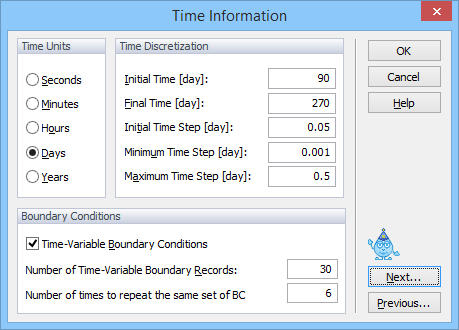The Time Information dialog window contains information associated with the Time Discretization, the Time Units, and the implementation of Boundary Conditions.

Time Information variables.
Time Units |
Time units [T] to be used throughout the application (years, days, hours, min, sec). When units are changed during or after data entry, then all input variables are converted automatically into the new units. |
Initial Time |
Starting time [T] of the calculation. |
Final Time |
Final time [T] of the calculation. |
Initial Time Step |
Initial time increment, Δt [T]. The recommended value for the initial time step depends on the type of simulation and boundary conditions used. When simulating a process that starts with a large initial pressure head or concentration gradient at the boundary (e.g., ponded infiltration or a sudden change of boundary concentration), use a small value of the initial time step (e.g., 1 s). When simulating a long term process with variable boundary conditions (e.g., seasonal or multiyear simulation), start with a larger time step (e.g., 15 min). This is because this initial time step is used whenever time variable boundary conditions significantly change (e.g., the water flux changes by 25% or more). If needed (if there is no convergence for Δtinit), the program will still use a smaller time step than Δtinit, but starting with larger Δtinit leads to more efficient calculations. In general smaller initial time steps must be used for soil with more nonlinear soil hydraulic properties (e.g., course textured soils) and larger initial time steps can be used for soil with less nonlinear soil hydraulic properties (e.g., loam). |
Minimum Time Step |
Minimum permitted value of the time increment, Δtmin [T]. The minimum time step must be smaller than a) the initial time step, b) interval between print times, and c) interval between time-variable boundary condition records. Always specify a small minimum allowed time step, on the order of 1 s. This value may never be used, but it provides the code with flexibility when it may be needed, e.g., when there is a sudden change in boundary fluxes and HYDRUS may not converge with larger time steps. |
Maximum Time Step |
Maximum permitted value of the time increment, Δtmax [T]. This is relatively unimportant parameter and a large value may be specified. Since HYDRUS automatically selects its optimal time step, there is usually no need to constraint that. The only time when there is a need to constrain the time step is likely for cases when HYDRUS is asked to generate internally intra-daily variations in temperature, or in evaporation and transpiration fluxes. Then there is a need to have time step smaller (e.g., 1 h) so that these daily variations can be properly modeled. |
Boundary Conditions
Time-Variable Boundary Condition - The Number of Time-Variable Boundary Records and time-dependent boundary conditions must be specified when this box is checked. The boundary conditions otherwise are assumed to be constant in time. The GUI can handle only a limited number of time variable data records (around 15,000; depending on the problem). If a required number of data records is larger than this number, a user needs to extend the ATMOSPH.in file manually using the following procedure.
The same set of boundary records can be repeated number of times (Number of times to repeat the same set of BC records) (periodically) with a time period tPeriod=tAtmLast-tInit, where tInit is the Initial Time and tAtmLast is the time of the last specified time boundary record. Note that tMax< tInit +n*tPeriod.
For details on units see Units in HYDRUS.
See also Notes on Spatial and Temporal Discretization.